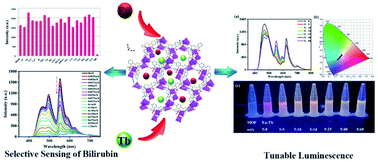A stable Ln(iii)-functionalized Cd(ii)-based metal–organic framework: tunable white-light emission and fluorescent probe for monitoring bilirubin†
Abstract
A novel anionic Cd(II)-based metal–organic framework, H2[Cd9(DDB)4(BPP)4(H2O)14]·4H2O·2DMA (1), was successfully obtained with a rigid carboxylate ligand 3,5-di(2′,4′-dicarboxylphenyl)benzoic acid (H5DDB) and a flexible pyridyl ligand 1,3-bis(4-pyridyl)propane (BPP). Complex 1 contains two-dimensional (2D) honeycomb structures and one-dimensional (1D) chain structures. The adjacent 2D structures are linked by strong intermolecular hydrogen bonds to form an ABAB 3D supramolecular structure, where the 1D chain structures traverse the channels of the 2D structures. Due to the anionic framework, Ln(III) ions (Ln = Eu and Tb) can be encapsulated in the framework of 1 by a post-synthetic modification process to obtain Ln(III)@1, where 1.09Eu(III)@1 (1a) and 0.658Tb(III)@1 (1b) can be obtained by soaking complex 1 in a Eu(NO3)3·6H2O or Tb(NO3)3·6H2O aqueous solution for 48 h. The liquid-state emission spectra of Ln(III)@1 can be tuned to be a white light emission by changing the Eu(III)/Tb(III) molar ratio in solution. Moreover, 1b can be used as a “turn-off” fluorescent probe for bilirubin with a low detection limit of 0.250 μM in phosphate buffer solution (pH = 7.4), which presents excellent sensitivity, high selectivity, and reusability. Furthermore, the devised fluorescent probe in serum also exhibits the fluorescence “turn-off” process with a low detection limit of 0.279 μM, and the recovery rate of bilirubin is 99.20–101.9%. The possible mechanisms of the fluorescence “turn-off” process can be explained by resonance energy transfer, and the weak interaction between 1b and bilirubin.



 Please wait while we load your content...
Please wait while we load your content...